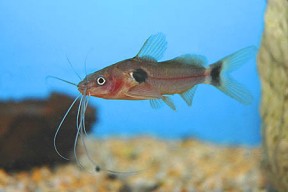Mystus bimaculatus
Two Spot Mystus
Classification
Bagridae
Distribution
This species occurs only on the island of Sumatra in Indonesia.
Habitat
It inhabits peat swamps.
Maximum Standard Length
2.4″ (6.5cm).
Aquarium SizeTop ↑
18″ x 12″ x 12″ (45cm x 30cm x 30cm) – 40 litres.
Maintenance
A biotope aquarium for this species would include the addition of peat as substrate. However, it will live quite happily without this. What is essential, is the provision of cover in the form of dense planting, driftwood and rocks. The use of floating plants to diffuse the light will also encourage the fish to be seen more often. Ideally, the water should be soft, acidic and stained with tannins. That said, the fish will survive in more alkaline conditions.
Water Conditions
Temperature: 74-86°F (23-30°C)
pH: 4.0-6.5
Hardness: 0-5°H
Diet
M. bimaculatus is an unfussy feeder and will accept most small live, frozen and dried foods. Feed a varied diet to keep the fish in good health and displaying their best colours.
Behaviour and CompatibilityTop ↑
Very peaceful with even the smallest fish. It can therefore be combined with a wide range of small to medium-sized species, including tetras, dwarf cichlids, anabantoids etc. Species found in the same areas in nature include rasboras, glass catfish (Krytopterus sp.) and gouramis. Maintain it in a small group, as it is more outgoing when in the company of conspecifics.
Sexual Dimorphism
Adult females tend to be rounder in the belly than males. Males also possess a small genital papilla located just in front of the anal fin. This resembles a single fin ray.
Reproduction
It has been bred in captivity but only via the use of hormone injections by commercial breeders. To achieve a successful natural spawn, one would need to set up a species tank with very acidic (pH 4.0-5.0) water of zero hardness and a layer of peat as substrate. Once the fish are in condition, it is suggested that substantial daily water changes with water of the same chemistry, but of a lower temperature than that in the aquarium, may trigger spawning.
NotesTop ↑
A delightful little species that deserves greater popularity in the hobby. All attempts at captive breeding should be encouraged, as its natural habitat is in danger of destruction by human activity.


